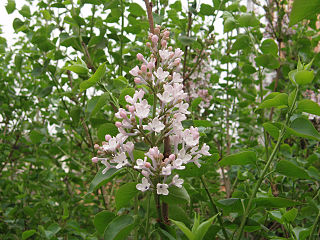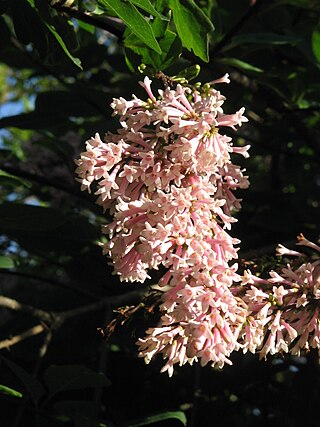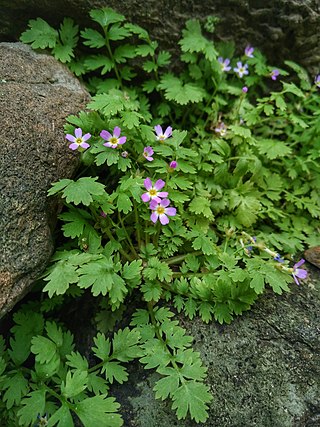
Pachypodium ambongense is a species of plant in the family Apocynaceae. It was first published as a species of the genus Pachypodium in 1924 by the botanist Henri Louis Poisson.

Pachypodium baronii, the Madagascar palm or bontaka, is a flowering plant in the family Apocynaceae. It has the habit of a robust shrub with a spherical or bottle-shaped trunk. It has several cylindrical branches at the top.
Pachypodium bicolor is a species of plant in the family Apocynaceae.

Pachypodium brevicaule is a species of plant that belongs to the family Apocynaceae.

Gossypium arboreum, commonly called tree cotton, is a species of cotton native to Indian subcontinent and other tropical and subtropical regions of the Old World. There is evidence of its cultivation as long ago as the Indus Valley Civilisation of the Indus River for the production of cotton textiles. The shrub was included in Linnaeus's Species Plantarum published in 1753. The holotype was also supplied by him, which is now in the Linnean Herbarium in the Swedish Museum of Natural History.

Eurybia is a genus of plants in the family Asteraceae that were previously included in the genus Aster. Most species are native to North America, although one is also present in northern Eurasia. There are 23 species in the genus, including 1 natural hybrid. The name was first applied by Alexandre de Cassini in 1820. The name is derived from Ancient Greek εὐρύς (eurús), meaning "wide", and βαιός (baiós), meaning "few", perhaps in reference to the small number of relatively wide ray florets.
Buddleja yunnanensis is a shrub native to Yunnan and much of the rest of south-western China, where it grows on forest margins, thickets, and along streams at elevations of 1,000 – 2,500 m. The shrub was first described and named by Francois Gagnepain in 1915. This species is distinct from and does not resemble Buddleja nivea var. yunnanensis, although sometimes the latter is erroneously labelled as B. yunnanensis.

Adenorandia is a monotypic genus of flowering plants in the family Rubiaceae. It was described by Vermoesen in 1922. The genus contains only one species, viz. Adenorandia kalbreyeri, which is found from west-central tropical Africa.

Searsia chirindensis is a medium-sized, semi-deciduous, trifoliate Southern African dioecious tree of up to 10 m tall, rarely 20 m, often multi-stemmed, occurring along the coastal belt from the Cape, through KwaZulu/Natal, Eswatini, Zimbabwe and Mozambique as far north as Tanzania, and growing in a wide variety of habitats such as open woodlands, in forests, along forest margins, in the open, among rocks and on mountain slopes. It was named by Swynnerton from a specimen collected by him near the Chirinda Forest in the Chipinge District of Southern Rhodesia. This is one of more than a hundred southern African species in the genus. It is commonly known as red currant because of a fancied resemblance of the fruit to that of the European redcurrant.
Branches dull brown or blackish, cylindric, pubescent or glabrous. Petiole 1·5–6·5 cm. long, almost cylindric, narrowly canaliculate and marginate above, pubescent or glabrous. Leaflets ± dull red-brown, ovate or ovate-lanceolate, acuminate, entire and ± undulate at the margin, membranous to ± rigid or subcoriaceous, glabrous or ± pubescent on the margin, midrib and nerves; median leaflet (3)6–13(16) × (1·2)2·5–4(7) cm., cuneate and frequently petiolulate at the base, the lateral ones (2)2·5–7(12) × (0·8)1·3–3·5(5·5) cm., asymmetric and slightly cuneate or somewhat rounded at the base, very shortly petiolulate to sessile; midrib slightly raised in the upper surface, very prominent below; lateral nerves arcuate, slender, raised on both sides, reticulation lax, almost invisible or sometimes conspicuous. Panicles terminal and axillary, ample, pyramidal, much branched, multiflorous, the terminal ones longer than the leaves, the axillary ones as long as the latter or somewhat longer; pedicels 1–2·5 mm. long. Male flowers: calyx-segments 0·5 mm. long, ovate, obtuse, glabrous; petals c. 1·5 mm. long, elliptic, obtuse; filaments c. 1 mm. long. Female flowers: ovary ovoid; styles reflexed; disk cupuliform, 5-lobulate; staminodes present. Drupe pinkish-yellow to reddish-brown, shining, (4)5(6) mm. in diam., globose, glabrous.
Kalanchoe fadeniorum is a species of Kalanchoe in the family Crassulaceae.

Syringa oblata is a species in the genus Syringa, in the family Oleaceae. It is also known as early blooming lilac or broadleaf lilac.

Syringa oblatasubsp.dilatata, also known as Korean early lilac, is a subspecies of the species Syringa oblata in the genus Syringa, in the family Oleaceae.

Syringa emodi is a species in the genus Syringa, in the family Oleaceae. It is also known as Himalayan lilac.

Syringa tomentella is a species in the genus Syringa, in the family Oleaceae.

Brachylaena rotundata is an occasionally deciduous Southern African shrub or small tree growing to some 8m in height and of the family Asteraceae. It occurs in eastern Botswana, Transvaal, Mozambique, Zambia and Zimbabwe, growing in open woodland, on rocky koppies and slopes, and on stream banks. Kew accepts Brachylaena rotundata S. Moore as a species while 'Flora of Mozambique' treats it as a variety of Brachylaena discolor DC. It bears attractive foliage, green on the upper surface and silver-grey on the lower, leaves turning slightly reddish in autumn.
Leaves with petioles from 2 mm to 7 mm. long, lamina 4–15 x 2.5–6 cm., larger on coppice shoots, broadly oblanceolate or elliptic, obtuse to rounded at the apex, cuneate or rounded base, entire, occasionally coarsely dentate near the apex; upper surface araneous when young, or glabrescent; lower surface greyish tomentellous with prominent veins. Capitula sometimes preceding the leaves, young synflorescences with buds in axillary and terminal spikes, mature synflorescences with numerous capitula in dense terminal panicles 4–40 cm. long, or in short raceme-like panicles in axils of old leaves. Involucres cyathiform to obconic. Phyllaries minutely glandular outside, subobtuse, margins ciliolate, the outer phyllaries from c. 1 mm. long and ovate, the inner to c. 5 mm. long becoming lorate-lanceolate, narrowly obtuse or blunt at the apex; the outermost 5–8 series decreasing in size and extending down to the base of the capitulum stalk. Male flowers: corollas dull-yellow, 3–5 mm. long, lobes c. 1.5 mm. long and ± recurved; pappus uniseriate, setae 3–4 mm. long, subplumose, the seta barbs exceeding the seta axis in width. Female flowers: corollas dull-yellow, 3–5 mm. long, filiform, lobes erect up to c. 0.5 mm. long; achenes c. 4 mm. long, subcylindric-fusiform, narrowly c. 8-ribbed, pubescent; pappus 2-several-seriate, setae 4–5 mm. long, ± terete or flattened, seta barbs ± equalling the seta axis in width.
Atropa pallidiflora is a close relative of the infamous deadly nightshade and, like it, is an extremely poisonous plant, containing a variety of tropane alkaloids valued in medicine for their anticholinergic, antispasmodic and mydriatic properties and deliriant in excess. Atropa pallidiflora is the least well-known of the four currently accepted species of Atropa and is endemic to the remarkable Caspian Hyrcanian mixed forests of Northern Iran, which can boast all the species of Atropa currently recognised, with the sole exception of the strictly Ibero-Maghrebi Atropa baetica. The binomial Atropa pallidiflora was published by Eva Schönbeck-Temesy in volume 100 ('Solanaceae') of Karl Heinz Rechinger's monumental Flora Iranica in 1972. The specific name pallidiflora signifies 'bearing flowers of a pale, wan or washed-out hue' and, while appropriate, is not especially evocative, given that the flowers of most Atropa species are far from vivid. The flowers of A. pallidiflora, like those of A.baetica, vary from greenish to yellow, but, as the designation 'having pallid flowers' might suggest, the yellow in question is a dingy greenish-yellow that is far from ornamental. The geographical term 'Hyrcanian' in the common name signifies that the plant is native to what was once the satrapy of Hyrcania, the name of which derives from an Iranian root meaning 'wolf' : Hyrcania is thus the 'Land of Wolves'. The name is an apt one, since the Hyrcanian forests have long been known as a hunting ground of legendary richness and beauty : the lush forests could support an abundance of large, mammalian herbivores, which in turn could support an abundance of apex predators - notably the wolf, but also the Persian leopard and even the tiger. The word 'Hyrcanian' will be familiar to any diligent reader of the works of William Shakespeare, as an epithet of the proverbially savage Caspian Tiger, known to the dramatist from his reading of the works of various Latin authors - who, in turn, were familiar with the Ancient Greek coinage 'Hyrcania' and the lands adjoining the Caspian Sea to which the place name referred. Regarding the richness of the Hyrcanian flora - of which Atropa pallidiflora is a noteworthy element - it is worth mentioning that the name of the modern Iranian province of Golestan has the delightful meanings of 'Rose Garden' and 'Land of Flowers'.

Podranea ricasoliana, called the pink trumpet vine, is a species of flowering plant in the genus Podranea, native to South Africa, Malawi, Mozambique and Zambia. It has gained the Royal Horticultural Society's Award of Garden Merit.
Gutenbergia rueppellii is an African species of flowering plant in the family Asteraceae.
Stenostephanus brevistamineus is a species of flowering plant first collected 11 July 2013 in Junín, Peru. Stenostephanus is a genus in the plant family of Acanthaceae. The species holotype is housed at HOXA, with isotypes at MO and USM.

Primula cicutariifolia, is a species of flowering plant within the genus Primula and family Primulaceae.














